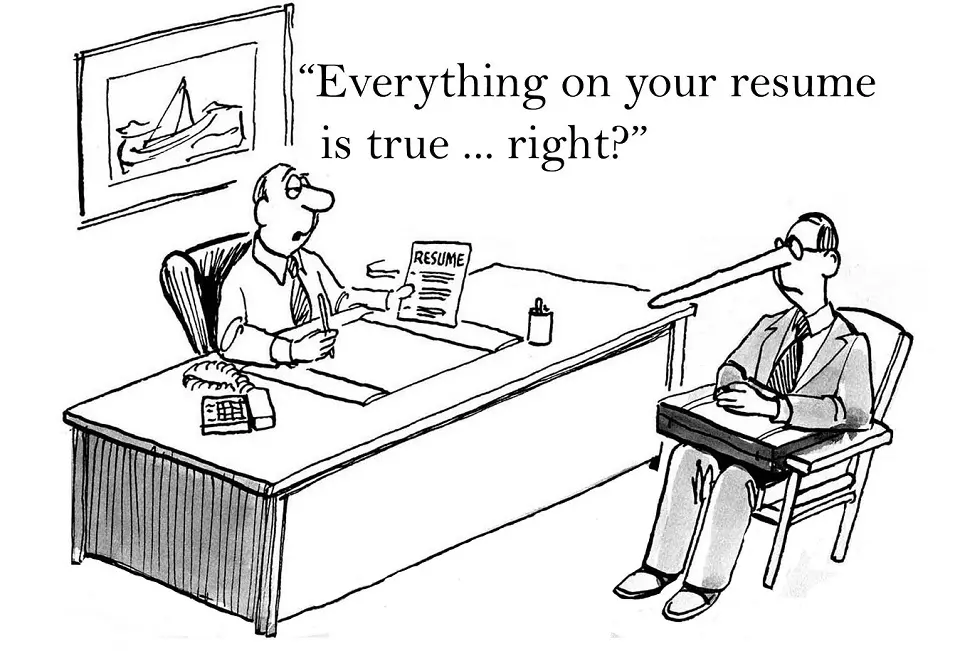Build Your Standout Resume: A Step-by-Step Guide

Writing a winning resume, which stands out, is an art form that not many people can do. Hiring managers take about 6 seconds to see whether your resume is worth reviewing. Adding too much information could be overwhelming, while too little information makes you appear inexperienced.
Technology has eased some of the burdens by filtering resumes of the best candidates, but if you do not use the right keywords, your resume will likely be dismissed before it’s even looked at.
This article will discuss common mistakes people make on their resumes and how to improve them to ensure your resume stands out and always lands at the top.
I recommend you read the effective LinkedIn Profile article to complement this resume guide.
Personalize Each Resume
One size does not fit all. Applying for jobs requires critical and strategic thinking. We should take time to review the job descriptions in detail and customize the resume according to the requirements of the role.
We all may have multiple skills and diverse experience even while our careers move in a focused direction. It is crucial to highlight the skills and experience the job description requires. It is always counterproductive to send the same resume to multiple employers across various industries and occupations.
While sending the same resume is time-efficient on the surface, you are likely being passed over because your resume either looks too generic or doesn’t match the actual job description.
For example, suppose you have good experience as an Information Technology Solution Architect and are applying for a Presales position. In that case, sending out the same resume you used to apply for a Solution Architect job may not be good, even though both require similar experience.
Therefore, in such a case, you should highlight your client-facing experiences along with your experience as a solution architect. If your resume does not include the word ‘presales,’ there is a good chance that the employer may not shortlist it.
Do not depend on the logic that the hiring manager will be able to read between the lines to understand your capabilities. Remember that the resume is initially screened either by a recruiter or a software program, and both will be looking for the right keywords.
Be Descriptive in Your Personal Work History
The job descriptions can guide you to the type of person and experience the employer seeks. However, when listing your professional history, it is more important to focus on what you achieved at your previous job rather than simply listing your work duties.
Examples:
“Worked as a Software Engineer in the Application Maintenance & Support Team – During this time, proactively analyzed 7 repetitive manual tasks and automated those to result in 300 hours per year or approximately USD 50,000 yearly savings.“
Or
“Worked as Business Development Manager responsible for selling the software product for insurance fraud detection – Achieved an average 25% year-on-year growth in sales during this period of 5 years, and except for one year, always achieved over 100% of the sales target.“
The first descriptions in the above examples are generic and sound like anyone could do it. Still, the second sentence in the above examples describes what you accomplished while working for the previous company.
Be brief, and ensure to use the keywords listed in the job description. For example, if a job description emphasizes “managerial experience,” try to use the word in your work description.
Avoid Over Exaggeration in Resume

Job applicants are expected to exaggerate some of their previous jobs’ accomplishments. The difference between teaching a class of 20 vs. 30 students is not that big, or creating 40 reports vs. 30 reports won’t matter. You’ll still have experience doing such tasks. However, it’s important not to exaggerate skills or experiences you can’t show.
If a job description requires someone with very strong QA automation skills but you only have basic exposure for a few months, you’ll likely be found out during the job interview. Be honest in mentioning your skills and experiences on your resume; if you can’t readily show them during an interview, leave them off the resume.
Some More Important Tips for Resume
It’s never easy to write an awesome resume, but it is still likely the most important document you will need to find a job.
Feeling a little lost in the resume writing department? Don’t worry; you are not alone. Here are 20 tips that will help you polish your CV and help it do you justice in your job search!
1. Delete Your Objective Statement
Objective: Aspiring for a challenging position with a leading organization, where my knowledge and experience can be enriched and enhance the organization’s bottom-line profitability.”
Isn’t it a bit obvious? Why else would you be submitting your resume? It takes up valuable space. One exception might be your first job application out of university if you want to express your deep-felt passion for a certain industry.
OR Worse…
Objective: Seeking a position in an organization where I can utilize and enhance my skills and expertise in QA manual testing and project management.”
Here, you have indirectly mentioned that it’s not their company you are interested in joining; rather, it can be any company, and you just want a job.
Why would a possible future employer care about your objective? An employer would only look forward to seeing whether you can meet their objective and do some value addition.
2. Remove “References Available Upon Request”
If a prospective employer wants references, they will ask for them. Use the extra space to add details about your abilities or accomplishments.
3. Spell and Grammar Check
One or two mistakes might not cause alarm, but consistent spelling and grammar mistakes throughout your resume show carelessness. As mentioned in the article about cover letters, you can use AI tools like Grammarly to check the grammar and improve the language.
Working in Japan requires attention to detail, even in positions where you would not use Japanese. After completing your resume, try to read it aloud to make sure everything is consistent and correct. You may also like to check how to write a Japanese resume.
If possible, have a fresh pair of eyes and give it a final look before submitting it. Writing a good resume takes time. However, it’ll be your first step to making a good impression on future employers, so putting your best effort into crafting each is essential.
4. Save In the Correct Format
It is always good to send your resume in PDF format. This format will ensure that your resume does not get messed up when opened on a different computer and will prevent accidental changes by anyone else.
5. Useful File Name
Instead of just “CV” or “Resume,” add your first and last name to the name of your resume file. If you are applying for a specific position, adding the position name to the file name is also a good idea.
Having a meaningful file name makes things easier for hiring managers. Moreover, it will also help you stand out more in their inbox saved folders and create a positive impression of your professionalism.
6. Make All Your Hyperlinks Live
Your resume will most likely be read on a computer, so making things like your email address, LinkedIn and other social profiles, and personal websites clickable increases the likelihood that someone will visit those pages and learn more about you.
If hyperlinks are unfamiliar, please look at This guide to adding hyperlinks.
7. Keep It Relevant
Your birthday, marital status, or religious preference are simply not the information on which a decision on whether to interview you should be based. They are irrelevant data and should be excluded.
8. Mention your Education at the End
An employer looking forward to hiring an experienced person is first interested in your experience, not your education.
Make sure that it is below your work experience. Unless you are a fresh graduate, chances are your last one or two jobs are more important and relevant to you getting the job.
9. Double-Check the Formatting
Make sure formatting is consistent across your resume. All headers should be in the same style, and all indentations should line up. Match all your bullet points as well. You do not want the styling to look sloppy!
10. Reduce Your Margins
Need a little more space to work with? Reduce your top and bottom margins to 0.5″ and your side margins to no less than 0.75″. This will keep your resume clean and readable but give you more room to mention what you do not wish to miss without possibly adding an extra page.
11. Leave School Education Out
Unless you have just left school or are one year out and need to bulk up your resume and did something highly relevant and awesome during your school years.
12. Quantify Everything
Go through your bullet points, and add as many numbers and percentages as possible to quantify your work. For example, how much did you increase revenue? By what percentage was efficiency improved? Quantified data is always so much more credible. Just make sure you can back it up if questioned.
13. Split Your Skills Section
If you have many skills related to a position, you can always try breaking them down separately, e.g., “Language Skills” or “Software Skills.”
14. Avoid Acronyms
Assuming that a recruiter or HR professional will know the meaning of an acronym for a title, certification, or organization is a potential disaster.
You should include the full name and acronym at least the first time, e.g., CFA (Chartered Financial Advisor), to ensure the recruiter knows what you are discussing. In today’s world of applicant tracking systems, the full name is also more likely to be picked up.
15. Design of Resume
Unless you are a designer or are applying for a role that requires a particularly creative resume, it is best to remove any visual elements. Keep it plain and simple. However, in some countries, adding your professional-looking picture to the resume is a good idea.
16. Proper Promotions
Worked multiple jobs within the same organization? Make sure to list them correctly on your resume and in a way where your upward internal movement is pronounced rather than becoming confusing.
17. Tell Your Story in the Summary Section
In the first 10 seconds, would someone who does not know you well be able to get a general idea of who you are and what you are about? If not, you might need to revisit your CV structure. Look at the info you included at the top of the page as ‘Summary. Does it pop? Does it grab the reader’s attention? If not, then rewrite it. Please note that the summary is like the soul of the resume.
18. Mention Your Value Additions
Pick a few statements to take one step further, and add what value additions you did in your previous jobs. By doing this, you clearly communicate what you are capable of and the direct benefit the employer may expect by hiring you.
19. Meaningful Bullet Points
Ensure each bullet point is necessary, readable, and interesting to everyone likely to read them. You never know how the screening process will work at a company.
The hiring manager or the hiring company’s internal recruiter may do the first screening. Keeping your bullet points meaningful will help you in either scenario.
20. Avoid Mentioning non-International Languages
Even if you have a good command of some regional languages not used in any business, mentioning those as known languages is irrelevant. Please avoid all such unnecessary information.
21. What You Did 10 or 20 Years Back Doesn’t Add Value
You may have a very long experience; however, the employer would be interested in your recent experience. You do not need to detail what you did 10 or 20 years back. Write in detail about your past 5-6 years of experience, and avoid going into details about very old work experiences on your resume.
Conclusion to Make a Winning Resume
Remember, your resume is more than a mere document; it’s a powerful representation of your professional journey and potential. It’s your personal brand’s showcase, highlighting your unique skills and achievements in a competitive job market.
Think of your resume as a living document that evolves with your career. Regularly update it to mirror your growing experiences and latest accomplishments.
Your Resume is not just about landing your next job; it’s about continuously shaping and sharing your professional story. So, as you apply these tips, envision your resume as a key that unlocks new opportunities, helping you stride confidently toward your career goals.
Remember that a stand-out resume creates much better chances for you to win your dream job.

Olivia is a Digital Marketer and writes content on HR and career-related topics. She was born in France and grew up in the US, UK, and Hong Kong. A Millennial who sees the world through a multi-cultural prism.
